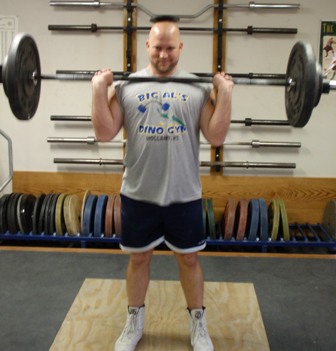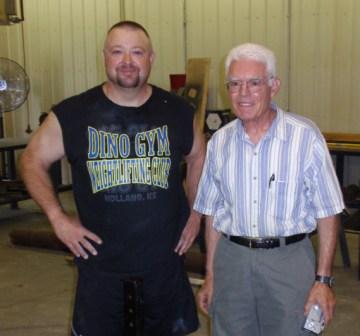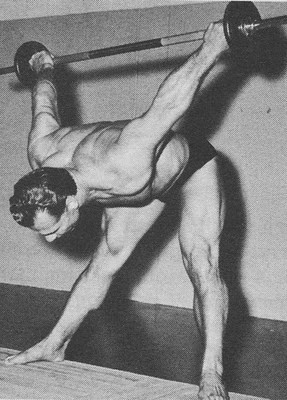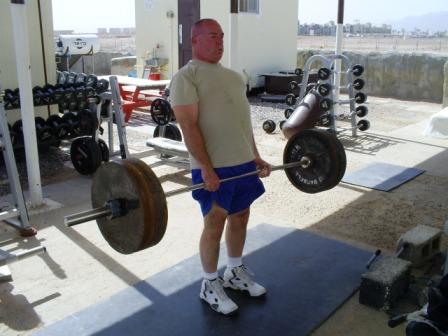by Al Myers
Ok, I’m getting tired of Thom getting all the recognition for his “human interest” stories involving his weightlifting life experiences, while the deep thought-provoking technical stories I write (which require actual research) get ignored (I actually wonder if anyone EVEN read my last one on the fairness of the Lynch Formula). It’s time I step up my game – and put a little controversy in what I write!! The truth is that I really don’t like to OFFEND anyone, and thus my avoidance of any story that may seem offensive. On the other hand, Thom doesn’t care if he gets hate mail! He even reads it with a smile on his face. That is what makes him a much better columnist than myself – but TIMES ARE A CHANGING and I’m going to try to “stir the pot” a little with this story. Here it goes – and I hope AT LEAST one person gets offended and makes a derogatory comment about this story on the USAWA Discussion Forum (and that’s NOT counting YOU Thom).

The Ziegler Clean even makes "The Champ" Chad Ullom look like a clown, despite the fact that he has lifted the most weight ever in this lift. But who really cares about that? All you see is that silly little plate balancing on the top of his head.
1. French Press – Definitely the WORST lift in our list of lifts. That is why I’m listing it first. Whoever wrote the original rule for this lift must have been a cynic. Why else would the rules of this lift be written in such a way that it is impossible to perform and COMPLETELY different than how it is performed in the gym by EVERYONE else that trains it? Judging this lift is even worse. Did the bar touch the neck? Did the elbows drop? The answers are always NO and YES. I have YET to see this lift performed the way our rules call for it to be done. Any lift that has rules so subjective that it would require instant replay in slow motion to make an official judgement needs to be RE-WRITTEN.
2. Press – Dumbbell, One Arm – This lift was just in the World Championships and after what I saw there it now makes my list of Ten Worse. The IAWA rules require the center of the rod of the dumbbell be no higher than the clavicle. Obvious the person who decided on this rule knew NOTHING about human anatomy. Do most lifters know where the clavicle is? From watching the judging, it was obvious the judges don’t. I have a copy of Gray’s Anatomy, I’ll send you a picture. It is MUCH lower than the top of the shoulder. Practically no one started the dumbbell this low (myself included!). Also, what’s up with all the side pressing when doing a dumbbell press? That’s not supposed to be allowed – we got ANOTHER LIFT for that one! The bottom line – this lift is performed and officiated differently than how the rules are written so SOMETHING should change to “keep it real”!
3. Deadlift – Stiff-legged – Another impossible lift to judge. Judging is ALWAYS very subjective and lifters will bend their legs and get the lift passed. And I can’t figure out WHY sumo deadlifting is allowed in the rules – it seems to defeat the purpose of a stiff legged deadlift.
4. Ziegler Clean – Come on, this lift is just ridiculous. Balancing a plate on your head while you do a clean? When I first heard of this lift I thought the person telling me about it must be joking. No one would really want to train for THAT!?! Lifts like this make a mockery of All-Round Weightlifting, and you got to know people probably LAUGH at us when we report on the Zeigler Clean.
5. Van Dam Lift – This lift got approved for one reason – us “selling out” for publicity that we never got. Did we really think Rob Van Dam and his professional wrasslin’ buddies were going to start lifting in our All-Round Meets? We should be ashamed of ourselves for approving this lift.
6. Inman Mile – Carry 150% of your bodyweight in the form of a bar across your shoulders for 1 mile?? Give me a break – even the person it was named after couldn’t do THAT!! This is just another “official lift” that makes us look like a goofy weightlifting organization.
7. Lano Lift – I respect the fact that lifts are named after someone deserving. I have met Jack, and I wouldn’t be surprised if he proposed this lift as a joke just to see if the membership was gullible enough to approve it. How many different movements are in the Lano Lift? I can’t keep track of them! Who would REALLY want to do this? It is the lift with the longest written rule in the USAWA Rulebook. Even Jack has never set a record in this lift that carries his name. That should tell you something.
8. Phumchaona Lift – Another screwball lift named after a famous USAWA lifter. This lift requires you to clean and press a pair of dumbbells WHILE doing a Hip Lift!! Like THAT is going to be better than your max Hip Lift. If I was going to do this lift, I would use a pair of 1/2 pound dumbbells and after doing my MAX Hip Lift just raise up my arms. This “official lift” is so stupid NO ONE has EVER done it. That’s right – NO ONE!!
9. Carter Lift – The only thing more ridiculous than clean and pressing a pair of dumbbells while doing a Hip Lift is SQUATTING a bar while Hip Lifting. But I’ll give John credit – the picture of himself performing this lift in our Rulebook does look IMPRESSIVE, and at LEAST he had the courage to perform his lift in public.
10. Weaver Stick – Absolutely IMPOSSIBLE to judge fairly. The arm is NEVER straight, and it only takes a tiny little bend to add a few pounds to this lift. The records in this lift really are meaningless. Now STRAP your arm to a fixed pole and THEN see what you can do in the Weaver Stick. That’s the way it should be done.
**** The above controversial comments are mine alone, and may not reflect the opinions of the USAWA membership. Please direct your hate mail to me and not to Thom Van Vleck****



